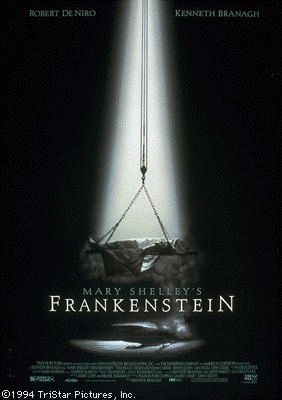
Mary Godwin wurde 1797 in London als Tochter der Frauenrechtlerin Mary Wollstonecraft (1759-1797) und des Revolutionärs William Godwin (1756-1836) geboren. Die Mutter starb als Mary zur Welt kam. Nachdem William 1801 wieder geheiratet hatte, wuchs sie mit vier Geschwistern verschiedener Eltern auf. Häufig wurde sie Freunden zur Pflege übergeben. Dadurch verbrachte Mary längere Zeit in Schottland. Früh erwachte ihr literarisches Talent. Mit zehn Jahren schrieb sie ihr erstes Buch.
1814 brannte Mary, noch nicht 17 Jahre alt, mit dem jungen Dichter Percy Shelley (1792-1822) durch. Bis zu ihrem 25. Lebensjahr war sie fünf mal schwanger. Aber nur ein Kind überlebte. Mary und Percy heirateten 1816. Im Frühjahr 1816 reisten die beiden mit Maries Schwester Claire in die Schweiz. Claire war auf der Suche nach Lord Byron (1788-1824). Während des Sommers verbrachten sie manche gemeinsame Nacht in seiner Villa Diodati. Mit von der Partie war auch Byrons Leibarzt John Polidori (1795-1821). Während gespenstischer Gewitternächte lasen sich die fünf gerne Schauergeschichten (gothic novels) vor. Eine dieser Nächte inszenierte der englische Regisseur Ken Russell 1987 in dem Film Gothic.
Angeregt durchs Lesen der Gruselgeschichten und unter dem Einfluß von Opiaten entstand die Idee, den Phantasien beim Schreiben eigener Schauergeschichten freien Lauf zu lassen. Aber nur Mary und John arbeiteten ihre Entwürfe aus. Mary erweiterte ihre Geschichte zum Frankenstein Roman, den sie 1818 veröffentlichen konnte. Im Alter von 19 Jahren hatte sie den ersten Science Fiction Roman geschrieben. John veröffentlichte 1819 die Erzählung The Vampyre. Damit löste er nicht nur die Vampirmode des 19. Jahrhunderts aus, sondern lieferte auch Bram Stoker (1847-1912) die Vorlage für seinen 1897 erschienenen Roman Dracula.
1822 ertrank Percy Shelley während eines Urlaubs in Italien. In Maries Leben bedeutete das einen tiefen Einschnitt. Durch den Erfolg ihres Frankenstein Romans widmete sie sich fortan der Schriftstellerei. Von ihren späteren Werken ist The Last Man hervorzuheben. Der 1844 erschienene Roman handelt vom Untergang der Menschheit im 21. Jahrhundert. Mary hatte nach dem Tod ihres Mannes nicht wieder geheiratet. Sie starb 1851 in London.
One of the phenomena which had peculiarly attracted my attention was the structure of the human frame, and, indeed, any animal endued with life. Whence, I often asked myself, did the principle of life proceed? It was a bold question, and one which has ever been considered as a mystery; yet with how many things are we upon the brink of becoming acquainted, if cowardice or carelessness did not restrain our inquiries. I revolved these circumstances in my mind, and determined thenceforth to apply myself more particularly to those branches of natural philosophy which relate to physiology. Unless I had been animated by an almost supernatural enthusiasm, my application to this study would have been irksome, and almost intolerable. To examine the causes of life, we must first have recourse to death. I became acquainted with the science of anatomy: but this was not sufficient; I must also observe the natural decay and corruption of the human body...
It was on a dreary night of November that I beheld the accomplishment of my toils. With an anxiety that almost amounted to agony, I collected the instruments of life around me, that I might infuse a spark of being into the lifeless thing that lay at my feet. It was already one in the morning; the rain pattered dismally against the panes, and my candle was nearly burnt out, when, by the glimmer of the half-extinguished light, I saw the dull yellow eye of the creature open; it breathed hard, and a convulsive motion agitated its limbs.
How can I describe my emotions at this catastrophe, or how delineate the wretch whom with such infinite pains and care I had endeavoured to form? His limbs were in proportion, and I had selected his features as beautiful. Beautiful!--Great God! His yellow skin scarcely covered the work of muscles and arteries beneath; his hair was of a lustrous black, and flowing; his teeth of a pearly whiteness; but these luxuriances only formed a more horrid contrast with his watery eyes, that seemed almost of the same colour as the dun white sockets in which they were set, his shrivelled complexion and straight black lips...
Oh! no mortal could support the horror of that countenance. A mummy again endued with animation could not be so hideous as that wretch. I had gazed on him while unfinished; he was ugly then; but when those muscles and joints were rendered capable of motion, it became a thing such as even Dante could not have conceived...
"I am thy creature, and I will be even mild and docile to my natural lord and king, if thou wilt also perform thy part, the which thou owest me. Oh, Frankenstein, be not equitable to every other, and trample upon me alone, to whom thy justice, and even thy clemency and affection, is most due. Remember, that I am thy creature; I ought to be thy Adam; but I am rather the fallen angel, whom thou drivest from joy for no misdeed. Everywhere I see bliss, from which I alone am irrevocably excluded. I was benevolent and good; misery made me a fiend. Make me happy, and I shall again be virtuous."...
"Slave, I before reasoned with you, but you have proved yourself unworthy of my condescension. Remember that I have power; you believe yourself miserable, but I can make you so wretched that the light of day will be hateful to you. You are my creator, but I am your master;--obey!"
Frankensteins Monster und das Unwesen des Grafen Dracula sind zu beliebten Filmthemen geworden:
Frankenstein von James Whale 1931
Mary Shelly's Frankenstein von Kenneth Branagh 1994:
Friedrich Murnaus Nosferatu, eine Symphonie des Grauens, von 1922
Roman Polanskis Dance of the Vampyres von 1967